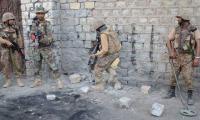After multiple extensions in the census date, the population count of Karachi has finally crossed the figure of 2017 census and reached 17.819 million as per the data shared by the Pakistan Bureau of Statistics (PBS) on Sunday.
This new data, however, still seems problematic as according to the current figures, the city’s population growth rate has decreased compared to 2017. The population count of Sindh, according to PBS Coordinator and Spokesperson Muhammad Sarwar Gondal, had reached 54.85 million on Sunday. This means the port city has 32.48 per cent of the province’s population.
Sindh Chief Minister Syed Murad Ali Shah had on Saturday said that by the 2021 actual population statistics, the population of the province could not be fewer than 75 million. According to the PBS, the house listing in 50 to 60 blocks in Karachi is still under way as the census has been extended till May 15.
Larkana division
Meanwhile, political parties based in Karachi are raising doubts as the population of the Larkana division has registered a significant increase.
The Larkana division's population, according to the ongoing census, is 7.946 million. It is not likely to increase as there is no further extension in the population count exercise in the districts that come under the Larkana division.
The Larkana division comprises five districts — Larkana, Kamber-Shahdadkot, Jacobabad, Shikarpur and Kashmore. On the basis of the current statistics, the population of the division is 14.49 per cent of Sindh's total population.
In the 1998 census, the Larkana division’s population was 13.83 per cent of Sindh’s population. In 2017, when the division’s population was 6.190 million, its percentage in the total population of the province had declined to 12.94 per cent.
The population growth of the Larkana division in 2017 was 2.05 per cent annually and by that rate, its population in 2023 would have been not more than 7 million.
Independent researcher Sadya Siddiqui told The News that the increase in the population of the Larkana division from 6.190 million in 2017 to 7.946 million in the current census might not necessarily be an anomaly.
Using the 2.05 percent growth rate, the population count should be near to 7 million in the Larkana division, she said. “The latest and perhaps final count of the Larkana division shows that it is almost at 8 million. This difference could be possible because of the de-jure methodology that was applied in the current census.”
Since the 1998 census, the Larkana division had 13.83 per cent of Sindh's population; in the 2017 census, this decreased to 12.94 per cent, but now the population had suddenly increased to 14.49 per cent of the province, she said, calling the phenomenon “unusual for a primarily rural division to have seen neither a massive migration nor an incredibly high growth rate from 2017 onwards”.
She explained that if this percentage was correct, it must be indicated in various socio-economic and health surveys that were conducted time to time.
Karachi population growth
Commenting on the trends of Karachi’s population, the researcher said that in the 1998 census, Karachi's population was 32.38 per cent of Sindh’s total population. In the 2017 census, the port city’s population rose to 33.49 per cent of the province’s total population.
With 17.819 million people counted so far in Karachi, the city’s population is 32.48 per cent of the entire province’s population, which is lower than the 2017 percentage.
“Even if the city’s percentage in the total population of Sindh reached 34 per cent, which is near the 2017 census percentage, this would mean that Karachi’s population growth rate is slower than that of Sindh’s,” Sadya said, adding that it was something not possible.
She said Karachi was among the fastest growing megacities of the world, according to projections made in the Karachi Strategic Development Plan 2020 and a study carried out by the Japan International Cooperation Agency in 2012.
“The city officially should have been at the 27.550 million mark by 2020 and by 2025 would have a population of 32.506 million people,” the researcher stated.
Fifth extension
The PBS has extended the deadline for the population count in various districts of the country, including all the seven districts of Karachi, for the fifth time until May 15.
Speaking to The News on the percentage problem of Karachi’s population, PBS Chief Statistician Dr Naeem uz Zafar said that a few days ago, it was drastically lower than what it was now. “Karachi is a huge city and enumeration is not easy here,” he said, adding that the number has improved and the enumeration is still under way.
He said that in 50 to 60 blocks, the listing of households was still under way in the city. “We have 3.1 million households in Karachi now, and the number is increasing daily,” he said.
He explained that due to incompetence of enumerators, nonliving population, which is a technical term for the people living in a particular area without being counted in the census, had emerged in many places but now such people were being counted.
Dr Zafar said the PBS had also been addressing anomalies in the earlier house count. He added that earlier some quarters had raised the point that almost nine per cent of the Karachi households had one-person family size, after which this issue was being addressed in the recount. He explained that actually single-person households were earlier seven per cent of the total household, which had now reduced to 3.5 per cent.
Commissioner’s statement
The Karachi Commissioner’s Office on Sunday in a press statement said that after their intervention, the buildings in the Cantonment Board Clifton where enumerators had earlier not been allowed to enter were now enumerated.
The PBS Karachi coordinator, Faraz Muslim, said an enumeration team entered inside the gated housing society, Emar, which had a total of seven towers and each tower had 26 floors having six apartments each. He explained that Emar had a huge population, which was now being enumerated after the intervention of the Karachi commissioner.
This picture taken on January 30, 2023, shows commuters passing through the Empress Market in Pakistan's port city of...
A resident of Tando Jam, Gulzar Ahmed , addresses to media persons during press conference, at Hyderabad press club on...
The front of the Sindh High Court building in Karachi. — AFP/FileThe Sindh High Court has directed the human...
The Sindh High Court building in Karachi. — APP/FileThe Sindh High Court on Thursday dismissed the National Bank...
This image shows Karachi Police personnel and commandoes standing guard on November 29, 2023. —...
The Sindh High Court building facade can be seen in this file image. — SHC Website/FileHYDERABAD: The Sindh High...







